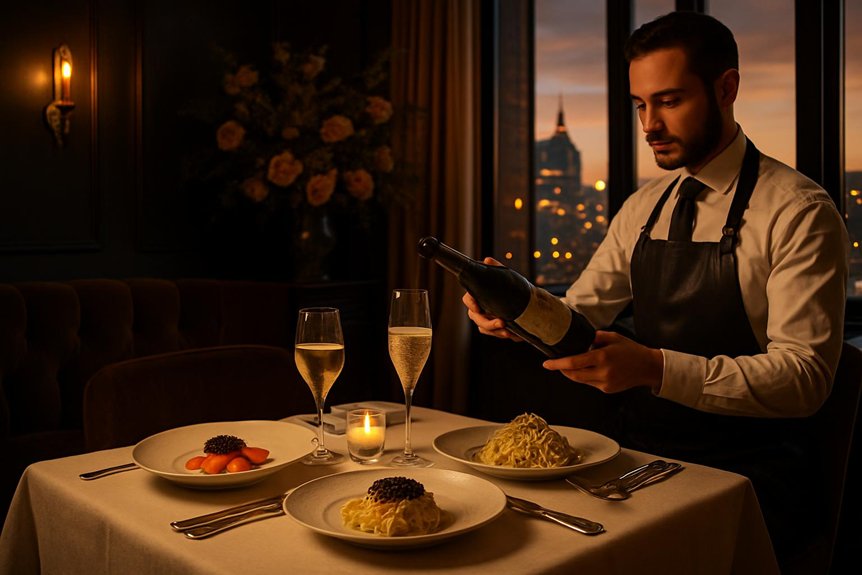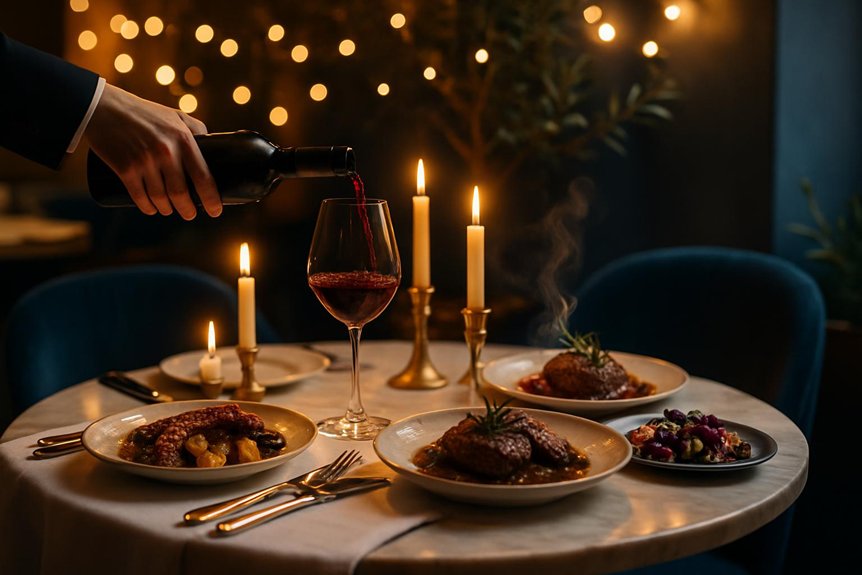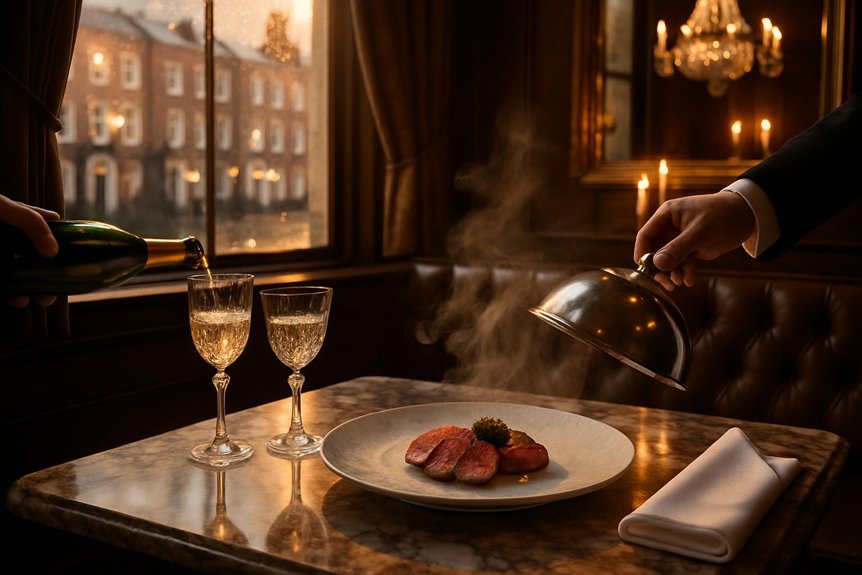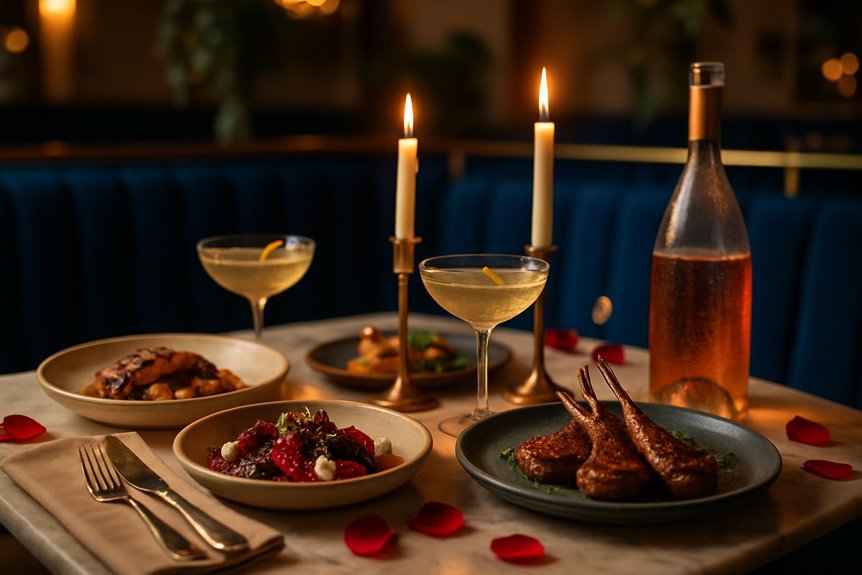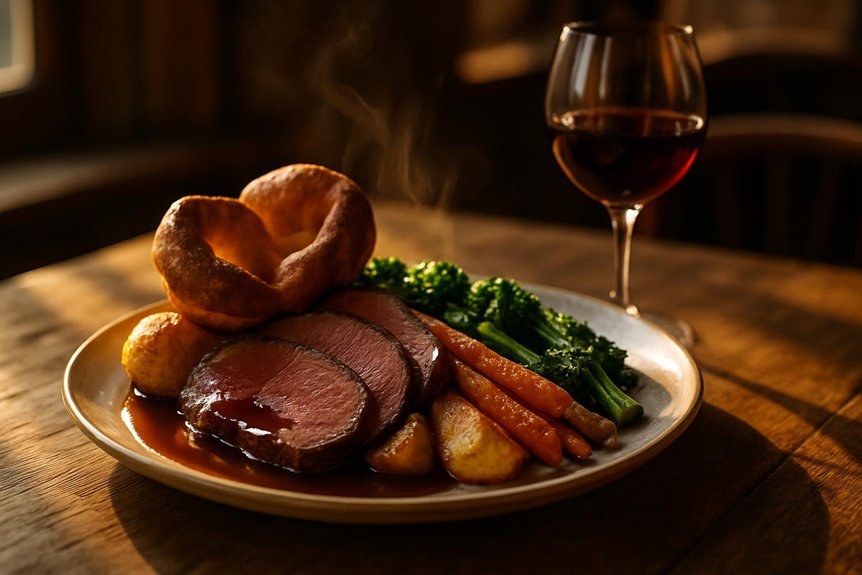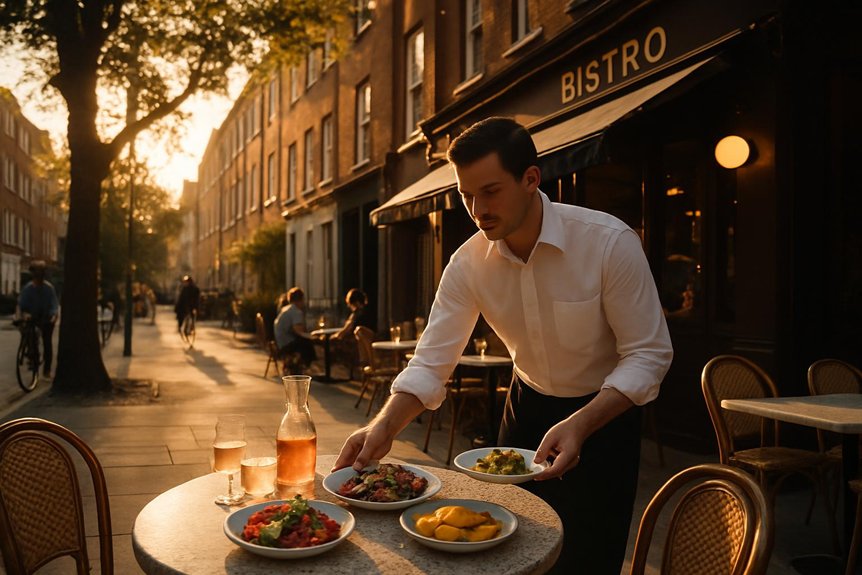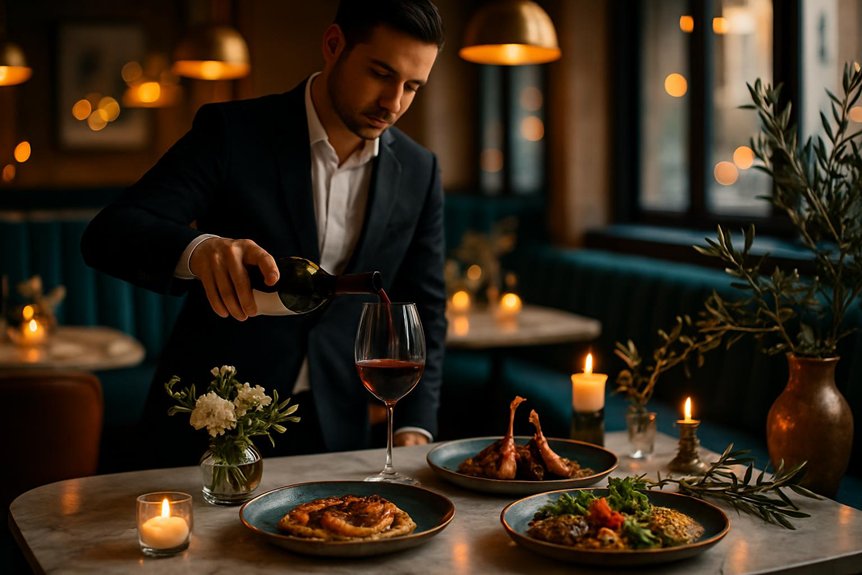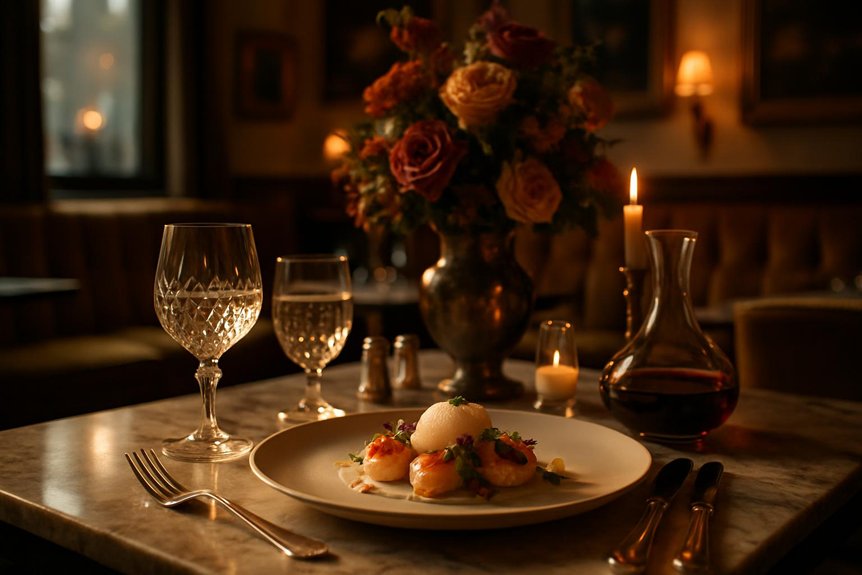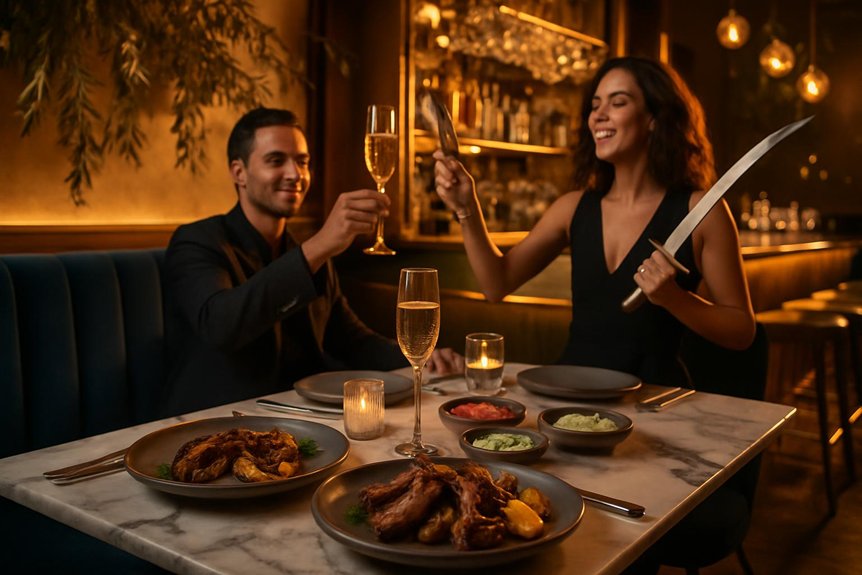London’s luxury restaurants balance innovation with restraint. Menus nod to heritage while tasting courses whisper modernity. Rooms glow with layered light, service moves with quiet precision, and sourcing leans seasonal and exacting. Chefs craft narratives plate by plate, from hidden counters to chandeliered salons. Wine lists reveal guarded treasures. Etiquette matters, yet intimacy is preserved. What unfolds behind these discreet doors—where stars meet storytelling—merits a closer look.
Michelin-Star Marvels: Where Stars Meet Storytelling
Few cities stage fine dining with the theatrical flair of London, and its Michelin-starred rooms serve as both kitchen and canvas. Here, chefs choreograph courses as narratives, guiding guests from prologue to finale with precision and restraint.
Dishes arrive with innovative plating that clarifies flavor rather than obscuring it, framing British produce through contemporary technique. Menus emphasize sustainable sourcing, tracing line-caught fish, heritage grains, and regenerative vegetables with unshowy rigor.
Wine pairings act as counterpoints, not echoes, broadening the storyline without distraction. Service reads the table with quiet intelligence, pacing courses to sustain momentum.
Interiors favor sculptural calm over spectacle, allowing texture, temperature, and aroma to speak. The result is culinary storytelling that prizes intention, seasonality, and disciplined imagination.
For those seeking a vibrant nightlife experience in London, Meraki Restaurant offers dining, dancing, and great vibes every Thursday, Friday, and Saturday.
Hidden Chef’s Counters and Discreet Dining Rooms
How does luxury taste when it whispers? In London’s hidden chef’s counters and discreet dining rooms, it tastes like proximity—unmediated, precise, and quietly theatrical. Seats are few, voices low, lights softened. The chef’s cadence replaces clatter, each course arriving as an intimate proof of intent.
Here, menus lean toward farm to table without sermonizing. Ingredients are handled with restraint, then heightened by exacting flavor pairing: saline against citrus, smoke against blossom, fat cut by bitter greens. Counters frame the craft; guests read technique as clearly as taste.
In private rooms, service calibrates tempo to conversation, not the other way around. Meraki, Fitzrovia offers a taste of luxury with its unique twist on Greek cuisine, making it a perfect spot for special occasions. Privacy is not secrecy but focus, a narrowing of bandwidth until only the plate, the pulse, and the palate remain.
Seasonal Sourcing and the Art of British Produce
In London’s luxury dining rooms, menus shift with the hedgerow and the tide, signaling a clear commitment to British seasonality. Chefs work directly with farmers and smallholdings, shaping harvests and breeds to meet exacting standards. Foraged coastal herbs and woodland finds sit alongside heritage varieties, giving familiar ingredients new precision and depth. Meraki Luxury Restaurant is a notable example of this dedication, offering a dining experience inspired by Greek cuisine with a focus on seasonal ingredients.
Celebrating British Seasonality
Why does London’s luxury dining scene feel most alive when the seasons turn? Because the calendar itself becomes a menu. Spring’s first asparagus, summer berries at peak gloss, autumn’s game, and winter’s brassicas arrive with stories of ingredient provenance, then appear as artful plating that highlights restraint rather than excess.
The city’s finest rooms act as galleries for fleeting flavors, elevating timing to a culinary principle.
Seasonality refines decision-making. Chefs adjust sauces, cooking methods, and textures to suit the moment: chilled consommés yield to roasted marrow warmth; citrus cuts through richer cuts as nights draw in.
Diners learn to expect brevity—dishes change not for novelty, but necessity. This disciplined rhythm guarantees luxury remains grounded, making each plate both a document of place and a timestamp.
Chef–Farmer Collaborations
A quiet pact underpins London’s top tables: chefs and farmers plan menus by field, tide, and weather. This partnership treats British produce as a moving calendar, aligning planting, harvest, and catch with service. Growers flag what thrives; kitchens respond with restraint, allowing flavor to lead. The result is a rigorously timed farm to plate rhythm, where supply informs creativity rather than the reverse.
Contracts are small, frequent, and flexible: brassicas one week, day-boat turbot the next. Organic sourcing is prioritized when conditions allow, with soil health, animal welfare, and traceability recorded as closely as cost.
Chefs visit barns and polytunnels, calibrating ripeness and size for precise cooking. Farmers receive feedback on texture and sugars, tightening a loop that refines luxury into seasonally fluent simplicity.
Foraging and Heritage Varieties
From those tightly tuned chef–farmer rhythms, sourcing stretches into hedgerows, foreshores, and old orchards where flavor is mapped by latitude and lineage. London’s top dining rooms now prize the immediacy of coastal samphire, Sussex chanterelles, and city-fringe wild herbs gathered at first light.
Foragers supply fleeting cues of the season—nettles, sea aster, pennywort—treated with the restraint usually reserved for grand cru wines.
Parallel to this is a quiet renaissance of historic cultivars: Ribston Pippins, Ashmead’s Kernel, Norfolk Horned apples, heritage peas and brassicas revived from seed banks. Chefs plate them to express micro-terroir, not nostalgia, pairing orchard acidity with aged dairy, or bitter greens with cured shellfish.
Menus shift weekly, guided by tide tables and seed catalogues, privileging provenance over spectacle.
Theatrical Tasting Menus That Push Boundaries
Though fine dining often prizes restraint, London’s most audacious tasting menus turn dinner into theater, fusing haute cuisine with storytelling, illusion, and sensory play. Chefs script sequences like acts, where aromas drift from hidden diffusers, plates arrive smoking under cloches, and edible trompe-l’oeil unsettles expectations.
Guests witness fusion cuisine reframed as narrative: sashimi disguised as English garden pebbles, venison paired with cacao mist, or a broth “brewed” tableside like perfumery.
Molecular gastronomy underpins the spectacle without eclipsing flavor. Spherified herb oils burst on the tongue to time a punchline; dehydrated shards amplify texture; soundscapes sync with courses to tilt memory and mood.
Service choreography—precise lighting cues, synchronized pours, whispered reveals—elevates pacing, turning a multi-course progression into a calibrated, sensory arc.
Classic Luxury Reimagined on the Plate
Spectacle yields to restraint as some of London’s luxe kitchens refocus on heritage and craft, polishing old-world dishes with modern precision. Menus revive classic sauces, precise stocks, and impeccable butchery, valuing clean lines over gimmickry.
Chefs respect lineage while adjusting textures and temperatures: lighter mousselines, clarified reductions, brittle tart shells with whisper-thin lamination.
Cultural fusion appears as a quiet accent, not a headline—consommé brightened with yuzu, Dover sole escorted by miso brown butter, a soufflé perfumed with Assam tea.
Artisanal craftsmanship anchors the experience: hand-turned vegetables, house-cured fish, tableside saucing executed with choreography.
Provenance matters, but technique leads, letting heritage breeds and seasonal bounty speak plainly. The result is luxury defined by rigor, balance, and enduring flavor rather than spectacle.
Sky-High Dining With Spectacular City Views
Even before the first course arrives, altitude recalibrates appetite: glass-wrapped dining rooms hover above London’s lattice of rivers, parks, and slate rooftops, turning the city into a living backdrop. Chefs frame plates to echo the skyline—precise, vertical, and light-bathed—while service adopts a calm cadence that lets the panorama do part of the storytelling.
Open kitchens reveal a disciplined kitchen culture, where timing aligns with sunset and courses land as landmarks glow to life.
Menus lean toward clarity: pristine seafood, char-grilled game, and vegetables treated with architectural restraint. Heat, smoke, and citrus cut through high-altitude stillness. Dessert artistry favors reflective glazes and airy textures, catching twilight like polished steel.
Guests leave with tastes mapped to views—memories organized by bridges, spires, and constellations of city light.
Wine Cellars, Pairings, and Sommelier Secrets
As skyline plates are cleared, attention drops beneath the floorboards to the city’s hidden treasuries of glass and oak. In these temperature-steady vaults, collections span Old World benchmarks and avant-garde biodynamics, cataloged with the precision of a watchmaker. Sommeliers translate archives into journeys, offering wine cellar tours that reveal provenance, cork condition, and resting angles.
Pairings favor balance over bravado: saline oysters with razor-edged Chablis; hay-aged lamb against cool, graphite Bordeaux; spice-led tasting menus tempered by off-dry Riesling. By-the-glass Coravin pours enable rare sips without committing to bottles.
Sommelier insights focus on structure—acid, tannin, texture—guiding guests beyond labels to intent. Private tastings encourage vertical comparisons, while half-bottle lists reward curiosity. Decanting is applied tactically, preserving energy rather than chasing theatrics.
Design-Driven Spaces: Ambience as an Ingredient
London’s most opulent dining rooms use architectural storytelling to signal narrative—from grand staircases that frame arrivals to textures that echo the menu’s provenance.
Immersive lighting schemes sculpt mood with precision, shifting from crisp aperitif brightness to candle-warm intimacy by course.
Together, structure and light act as silent hosts, shaping perception before a single bite is taken.
Architectural Storytelling
A growing number of London’s luxury dining rooms treat architecture as a narrative device, shaping mood and memory before a menu is opened. Walls become chapters: artistic murals reference trade routes, artisans, or seasonal landscapes, while decorative tapestries soften acoustics and frame historical motifs.
Vaulted ceilings, colonnades, and sculpted staircases guide circulation like plot points, revealing bar, salon, and chef’s counter in measured sequence. Materials speak in dialects—Calacatta marble, burnished oak, patinated brass—each cueing era, craft, and intent.
Sightlines choreograph anticipation, placing ovens, cellars, or carving stations as staged reveals. Thresholds compress, then expand, to heighten arrival. Private alcoves read as epilogues, offering intimacy without isolation.
In these rooms, architecture curates appetite, positioning cuisine as the final act.
Immersive Lighting Schemes
Though plates and palettes command attention, light sets the script. In London’s luxury dining rooms, immersive lighting schemes choreograph attention, pace, and intimacy. Designers layer temperature, direction, and intensity so courses unfold like acts. Neon atmospheres punctuate bars and chef’s counters, while mood lighting softens edges, preserving privacy without obscuring craft.
The result is a calibrated theatre where shadows guide sightlines and reflections animate materials.
- Dynamic dimming maps to service rhythms, brightening during plating, tapering for conversation.
- Tunable white balances seasonal menus, shifting from crisp aperitif tones to warmer dessert hues.
- Accent beams sculpt textures—linen grain, shell glints, glaze ripples—heightening tactile perception.
- Concealed LEDs and mirrored coves expand spatial volume, diffusing glare and directing focus without visual clutter.
Service Choreography: The Human Touch of Fine Dining
How does a dining room move with such quiet precision that guests scarcely notice the effort? In London’s luxury rooms, waitstaff choreography governs the flow: steps mapped to courses, trays angled like compasses, glances used as signals. Napkins are refolded as if by sleight of hand; cutlery lands without a sound. Seamless guest interactions rely on timing—water poured between sentences, sauces offered at peak heat, allergies anticipated before a menu is opened.
Captains read tables like scores, measuring pace by laughter, posture, and the level of conversation. Service stations hum softly, a backstage of polishing cloths and whispered confirmations. The human touch remains central: names remembered, preferences logged, surprises calibrated to feel spontaneous while rooted in meticulous rehearsal.
How to Book, Dress, and Dine Like a Local Insider
Two truths guide Londoners who dine well: plan ahead and look effortless. A local insider secures the table first, then curates the tone. Weeknight seats are won with deft reservation tips: use waitlists, call at 10 a.m., and watch late releases.
Lunch often yields quieter rooms and the same kitchens at friendlier prices. Dress codes skew understated—tailored, not flashy; polished shoes, muted palettes, and a coat that knows where the cloakroom is.
- Booking: set alerts, be flexible with time, and confirm politely on the day.
- Arrival: announce the name, accept the pace, and avoid seat-hopping.
- Ordering: share starters, trust daily specials, and pair wines by the glass.
- Etiquette: minimal phones, discreet photos, fair service charge, and sincere thanks—true local dining.
Conclusion
In the end, London’s luxury restaurants read like love letters sealed with wax, each course a stanza, each room a hush. Craft meets conscience, heritage hums beneath neon halos, and service moves like a well-rehearsed ballet. Diners leave with pocket watches of memory, ticking long after the final pour. Here, stars converse with stories, and candlelight edits the night. Appetite becomes art, etiquette becomes ease, and the city’s heartbeat—softly mic’d—keeps time for the next reservation.
